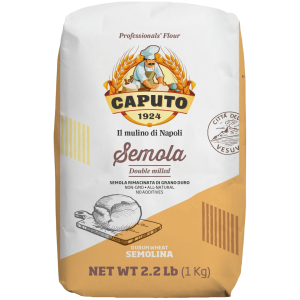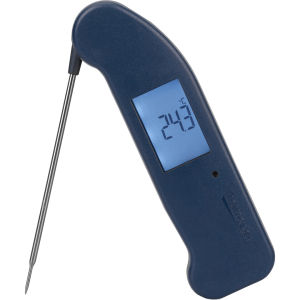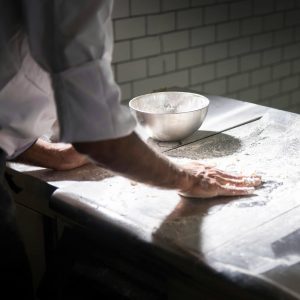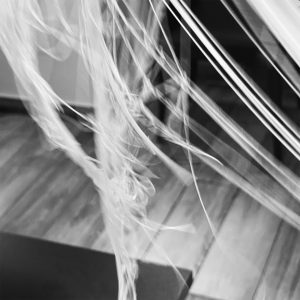How To Make
Su Filindeu
Learning su filindeu is like making black belt in karate.
Leo Gelsomino (Lello Pasta Bar)
Don't be fooled by its apparent simplicity

On paper, making su filindeu should be simple enough. After all, the dough contains nothing more than semolina flour, water, and salt, so how hard can it be? The tricky part, one that requires untold hours of practice to master, is knowing the difference between extensibility (stretchability) and elasticity (recoil) because you need to be able to control these two things carefully to pull and stretch the dough over and over without tearing it.
Local conditions have a huge impact on how dough behaves. Differences in temperature, humidity, altitude, water hardness and air circulation affect its “personality”. This is the reason why it is simply not possible to provide a precise recipe for su filindeu that is guaranteed to work every time. It’s also the reason you won’t find Sardinian cooks measuring the ingredients using anything other than their intuition.
The best we can do is provide broad guidelines, but ultimately you must figure out whether the dough needs to be kneaded for longer, rested for longer, have a little more water or a little more flour to achieve the texture you are striving for. It’s something that must be sensed by the pasta maker and that level of intuition can only be learnt through a huge amount of trial and error.
You have to be good at knowing when to add more water or less. It sounds a cliché but you can feel the dough changing. It almost speaks to you and tells you when it's ready.
Luca Floris (Nuoro resident)
Ingredients matter

You will need to produce around 600g of dough to complete one whole 60cm disk of su filindeu.
As a broad guideline, the quantities you need for each ingredient are as follows:
Semolina: 400g
Water: 200g
Salt: 4g
Semolina flour
Don’t underestimate the importance of using the right kind of flour. You need to track down finely ground, high-quality, double-milled semolina flour with between 12-14% protein. The coarse stuff sold by most supermarkets is unsuitable because the larger granules make it more prone to tearing when stretched.
Most Sardinian chefs favour stone-ground flour from the Stone and Wheat Mill (Mulino La Pietra e il Grano di Nurri) which has been stone-grinding durum wheat since 1931. It’s very hard to track down outside of Sardinia, so instead we recommend semolina from the Naples-based company Caputo. If you can’t track that down, just search online for “semola rimacinata”.
Salt
Salt has two purposes in the making of su filindeu. Firstly, it is used for taste, and secondly for its effect on the extensibility of the dough.
Salt has both positive and negative effects on extensibility. At low levels (between around 0.5% – 2%) salt tightens and strengthens the gluten network by interacting with the gluten proteins (gliadin and glutenin). This added strength helps the dough hold together during stretching. It also allows proteins to absorb water more efficiently, making the dough smoother and more pliable.
At higher concentrations (2% and over) salt strengthens the gluten network too much, making the dough stiff and resistant to stretching. It also starts dehydrating the gluten, reducing extensibility and making the dough more prone to breaking.
The trick is to use salt sparingly, ensuring it enhances the dough’s properties without overpowering them.
We favour unprocessed, fine sea salt from Trapani in Sicily, but any high-quality sea salt will do.
You can use table salt if that’s all you have to hand, but it tends to contain additives like calcium silicate (an anti-caking agent) or is fortified with iodine which can impart a metallic taste. When you’re producing something with just three ingredients, the quality of each one really counts!
Water
The mineral content of water has a small impact on a dough’s elasticity, as does its hardness, but ultimately this is far less important than your skill at pulling the dough. We have never felt any need to buy specific water when making su filindeu, as we consider consistency far more important. Using the same water source every time you make the dough will help ensure predictable results.
Until recently, there were only three women on Earth who could make su filindeu, all of whom live in Sardinia.
Atlas Obscura
Equipment
Su filindeu doesn’t require any specialist equipment to make, but beginners might benefit from a few pieces of kit to increase their chances of success.

Look online and you will find Italian nonnas making su filindeu with little more than experience, judgement, and intuition. For everyone else, there are a few tools that will make your life a lot easier.
Mixing bowl: This to mix the semolina, water and salt.
Digital scales: Precision scales help beginner pasta makers to ensure consistency between attempts.
Digital thermometer: This is useful if you decide to make your dough using warm water. The optimum temperature is around 40°C as this will help hydrate the flour, producing a softer, more pliable dough that is easier to knead.
Fundu: This is the disc on which the pasta is laid on to dry, although any food-grade circular board will do.
Solid wood board: This is not essential, but bakers and pasta makers favour wood over any other type of surface. This is because wood’s natural texture helps grip the dough as you knead it.
Two small bowls. You will need these to hold plain and salted water.
Magnetic stirrer. This is complete overkill, but we use it to dissolve salt in water without having to stand there stirring it by hand.
Many people say I have a secret I don’t want to reveal. But the secret is right in front of you. It’s in my hands.
Paulo Abraini (Nuoro resident)
Your Workstation
Su filindeu requires you to work at speed, so having a well-organised workstation is vital.

Fill one bowl with plain tap water and the other with salted water. In Sardinia, cooks will throw a generous handful of coarse sea salt into the bowl and cover it with water. If you want complete control over the process (and this comes back again to consistency) you can measure both the salt and water to achieve a precise salinity.
Some people recommend the water be “as salty as the sea” which is around 3.5% salinity. However, we have also seen someone recommend the water should be at the highest possible salinity which at room temperature is around 36%.
The easiest way to achieve the perfect amount of salinity for you is to weigh the water and salt with digital scales. We suggest measuring 100g of water and 10g of salt to start with and see how you get on.
Prepare a clean wooden surface and securely place your fundu within easy reach. There is nothing worse than seeing your threads fall apart as you walk across to the other side of the room.
Some of the older people don’t want to share their traditions, but the younger people are finding that if we don’t, sooner or later we’re going to lose them.
The Technique

Weigh 400g of fine semolina flour and place in a large mixing bowl. Add 200g of 40°C water (or simply use lukewarm water from the tap if you don’t have access to a thermometer). Add a generous pinch of salt.
Mix by hand until the ingredients start forming clumps. Add a little more water or a little more flour if the dough feels too wet or too dry.
When the dough starts to come together, transfer it to your wooden work surface and start kneading until it becomes silky smooth.
Unlike making bread or pizza where cooks must knead the dough in a circular motion to distribute the gluten network randomly, that doesn’t work for su filindeu. Instead, you must focus on kneading linearly, the easiest way being to roll your dough into a rope and when it gets too long, take both ends and stick them together and repeat the process until the dough is silky smooth. This typically takes between 15 and 20 minutes but it won’t hurt to go a little over this.
Cover the dough with clingfilm and allow it to rest at room temperature for at least one hour, preferably a little longer. When you are ready to start stretching, reawaken the dough with a quick knead and tear off about 1/6 of the dough. Cover the rest in clingfilm to ensure it doesn’t dry out.
When you think your dough is at the perfect extensibility, roll it into a 1 metre-long rope and connect the ends and pin them onto the palm of your hand to create two strands. (We tend to use our dominant hand to hold the dough and non-dominant hand to do the stretching, but try both and see which comes naturally to you.)
Allow the two strands to dangle vertically, take the looped end and confidently pull it as wide as your arms allow. Stick the looped end onto your dominant hand to create four strands. Repeat this process another six times until you end up with 256 microscopic noodles, each one as thin as a strand of hair.
Take the delicate strands to your fundu and lay them down the centre. Gently remove any excess dough dangling from the edges of the board and start the process again, layering the strands towards the edges until the entire board is covered.
Take a breather, but only for a few seconds because this process needs to be repeated twice more, with each new layer arranged at about 60° from the first layer. This produces su filindeu’s trademark criss-cross lattice pattern. You must work quickly because your next layer must be laid before the one before has had a chance to dry. The dough will only stick properly to wet dough and this ensures it doesn’t fall apart when you get to cooking the pasta.
Completing the three layers takes the world’s most famous su filindeu maker, Paola Abraini, around 20-25 minutes, something she can only do thanks to her 50 years of experience.
Once complete, place the fundu in a warm place to dry. At the height of the Sardinian summer, makers leave it in the sun for around two hours. However, it can take up to 48 hours to dry if you are making in poor weather conditions.
Now is your chance to hold this brittle circle of pasta up to the light and admire your handiwork. Get some photos because before long you’re going to break your creation into small pieces ready for serving.
